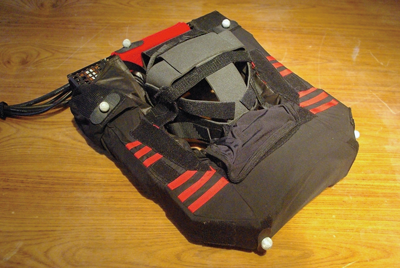Crescent, Inc. specializes in image engineering with a wealth of motion-capture expertise, including its own proprietary software and original image content creation. Crescent’s experience and reputation have given the company many unique opportunities, including an instrumental role in bringing the hit Japanese movie Shin Godzilla to life. “We used our motion capture techniques to capture, create and process the movements of Godzilla in full CG based on the movements of kyogen performer Mansai Nomura,” said Tatsuhiko Kobayashi, Crescent software engineer.
Motion capture is an animation technique that records human movement patterns into a digital form to supply realistic actions to digital characters. Crescent’s deep focus on extending its capabilities in this field led the company to developing its very own head-mounted display (HMD) for virtual reality (VR) through in-house 3D printing. What began as an effort to alleviate itself from the cost and delays of suppliers for rigid motion trackers has since grown into a successful independent product development effort with extended expertise in a growing market.
“Three years ago we incorporated a 3D printer into our operations to develop our own rigid motion trackers for CGI,” said Kobayashi. “By bringing 3D printing in-house we have now found new opportunities for development within VR and HMD.”

3D printing rigid motion trackers in house inspired Crescent to extend innovation elsewhere.
Extending expertise through innovation
The close relationship between motion-capture technology and VR led Crescent to start developing and providing HMDs for VR since the industry’s early stages in 2010. HEWDD-1080, Crescent’s first HMD, is in a category of its own as far as consumer-facing VR products are concerned. Its exceptional viewing angle, high resolution, and high quality images set its user experience apart, and it occupies a unique space in the industrial-use HMD market as a favored product by major companies, universities, and labs. Yet its development was not without challenges. Weight was an early tradeoff for its high level of performance.
“Since the beginning, people have wanted an HMD that was lighter and easier to handle,” said Kobayashi. “With the recent booming interest in the VR industry we started developing a next-generation model, HEWDD-2.”
Starting in the summer of 2015, the goal became to make the HMD wireless and lighter weight while maintaining the viewing angle, resolution, and image quality. To deliver an HMD casing that met Crescent’s standards, the component parts would need to fit together perfectly with a highly-refined finish. Yet with the early HMD aluminum frame exceeding 1kg, reducing weight became the biggest challenge.
“Our CEO Kotani helped us solve the weight issue with his insight that we didn’t need a mass production solution. His suggestion of a 3D printer reframed our approach and our capabilities,” said Kobayashi.

The close relationship between motion-capture and VR led Crescent to develop a new head-mounted display.
On demand production enables customization
Crescent found the precise and durable 3D printing solution it needed with 3D Systems’ ProJet MJP 2500 Plus, which enabled Crescent to manufacture lightweight parts in-house with benefits above and beyond expectations, including unique customization options to help advance functionality for different user groups.
“The ability to make various custom shapes on demand is a big plus,” said Kobayashi. “Sometimes we get orders from people who want their HMD for academic purposes, so they need eye trackers. In those cases, we attach sensors. Some people ask for AR shooting functionality, so we mount cameras.”
High quality parts fast
Crescent had already experienced the speed and reliability of 3D Systems’ printers through its work in custom motion trackers and was immediately interested in growing its in-house operations with the ProJet MJP 2500 Plus. Offering high quality, true-to-CAD parts in rigid plastic and elastomeric materials, the ability to print sharp corners and edges with detailed precision were a compelling selling point for Crescent. Kobayashi says the 32-µ layer resolution of the printer was more than enough for Crescent’s precision requirements and the wax supports and MJP EasyClean system were also a huge bonus.
The ProJet MJP 2500 Plus delivered Crescent’s second-generation HMD components exactly as designed, including threaded screw holes and screw clamps. Furthermore, with the ability to easily melt away wax supports the company could avoid time intensive finishing tasks that postpone processes and tie up resources.
Crescent’s next-generation HMD is wireless, weighs 300-400 grams less than the previous model and is equipped with a low-distortion lens with an exclusive optical feature that allows glasses-wearers to use it as well.
“I expect we will be using the ProJet MJP 2500 Plus a lot from now on,” said Kobayashi.
